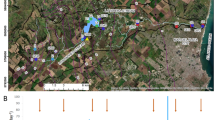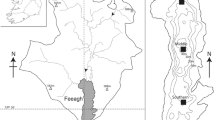Abstract
Human activities have altered riverine silica cycling and diminished the supply of silica to the oceans, but few rivers have been intensively monitored to evaluate the magnitude of these changes. In this study we measured dissolved silica (DSi) and amorphous silica (ASi) fluxes into and out of two large, culturally-impacted natural impoundments of the upper Mississippi River, Lakes St. Croix and Pepin, USA. ASi sedimentation rates and sediment–water fluxes of DSi were calculated for each lake, and a mass-balance approach was used to determine in-lake ASi production. ASi from terrestrial phytoliths in the lake sediments was determined to be only partially available to biotic recycling, and in-lake ASi dissolution was small relative to the total silica budgets. The river reaches upstream of the two lakes were found to have abundant DSi, and riverine diatom production was found to contribute significant amounts of ASi to each lake. The average total phosphorus concentration in Lake Pepin is four times that in Lake St. Croix but ASi production in Lake Pepin is only 2.3 times higher than in Lake St. Croix, indicating that diatom growth in Pepin is limited by factors such as turbidity. Lake St. Croix currently traps about 10% of the inflowing total bioavailable silica (TSib = DSi + ASi) while Lake Pepin traps closer to 20% of its inflowing TSib, clearly demonstrating the importance of silica retention in lakes and reservoirs along the land–ocean continuum.







Similar content being viewed by others
References
Applin KR (1987) The diffusion of dissolved silica in dilute aqueous solution. Geochim Cosmochim Acta 51:2147–2151
Battarbee RW (1973) A new method for estimating absolute microfossil numbers with special reference to diatoms. Limnol Oceanogr 18:647–653
Caraco NF (1993) Disturbance of the phosphorus cycle: a case of indirect effects of human activity. Trends Ecol Evol 8:51–54
Carlson RE (1977) A trophic state index for lakes. Limnol Oceanogr 22:361–369
Cary L, Alexandre A, Meunier J-D, Boeglin J-L, Braun J-J (2005) Contribution of phytoliths to the suspended load of biogenic silica in the Nyong basin rivers (Cameroon). Biogeochemistry 74:101–114
Conley DJ (2002) Terrestrial ecosystems and the global biogeochemical silica cycle. Global Biogeochem Cycles 16:1121. doi:10.1029/2002GB001894
Conley DJ, Schelske CL (1989) Processes controlling the benthic regeneration and sedimentary accumulation of biogenic silica in Lake Michigan. Archiv fur Hydrobiologie 116:23–43
Conley DJ, Schelske CL (2001) Biogenic silica. In: Smol JP, Birks HB, Last WM (eds) Tracking environmental change using lake sediments. Kluwer Academic Publishers, Dordrecht
Conley DJ, Kilham SS, Theriot EC (1989) Differences in silica content between marine and freshwater diatoms. Limnol Oceanogr 34:205–213
Conley DJ, Schelske CL, Stoermer EF (1993) Modification of the biogeochemical cycle of silica with eutrophication. Mar Ecol Prog Ser 101:179–192
Conley DJ, Wulff F, Stockenberg A, Carman R, Johnstone RW (1997) Sediment-water nutrient fluxes in the Gulf of Finland, Baltic Sea. Estuar Coast Shelf Sc 45:591–598
Conley DJ, Stalnacke P, Pitkanen H, Wilander A (2000) The transport and retention of dissolved silicate by rivers in Sweden and Finland. Limnol Oceanogr 45:1850–1853
DeMaster DJ (1981) The supply and accumulation of silica in the marine environment. Geochim Cosmochim Acta 45:1715–1732
Dixit AS, Van Cappellan P, Van Bennekom AJ (2001) Processes controlling solubility of biogenic silica and pore water build-up of silicic acid. Mar Chem 73:333–352
Edlund MB, Engstrom DR, Tripett LD, LaFrancois B, Leavitt P (in press) 20th century eutrophication of the St. Croix River (Minnesota-Wisconsin, USA) reconstructed from the sediments of its natural impoundment. J Paleolimnol
Engstrom DR, Almendinger JE, Wolin JA (in press) Historical changes in sediment and phosphorus loading to the Upper Mississippi River: mass-balance reconstructions from the sediments of Lake Pepin. J Paleolimnol
Foy RH (1985) Phosphorus inactivation in a eutrophic lake by the direct addition of ferric aluminium sulphate: impact on iron and phosphorus. Freshw Biol 15:613–629
Friedl G, Teodoru C, Wehrli B (2004) Is the Iron Gate I reservoir on the Danube River a sink for dissolved silica? Biogeochemistry 68:21–32
Friedrich J, Dinkel C, Grieder E, Radan S, Secrieru D, Steingruber S, Wehrli B (2003) Nutrient uptake and benthic regeneration in Danube Delta Lakes. Biogeochemistry 64:373–398
Gallego L, Distel RA, Camina R, Rodriguez Iglesias RM (2004) Soil phytoliths as evidence for species replacement in grazed rangelands of central Argentina. Ecography 27:725–732
Gibson CE, Wang G, Foy RH (2000) Silica and diatom growth in Lough Neagh: the importance of internal recycling. Freshw Biol 45:285–293
House WA, Denison FH, Warwick MS, Zhmud BV (2000) Dissolution of silica and the development of concentration profiles in freshwater sediments. Appl Geochem 15:425–438
Humborg C, Ittekkot V, Cociasu A, Bodungen Bv (1997) Effect of Danube River dam on Black Sea biogeochemistry and ecosystem structure. Nature 386:385–388
Humborg C, Blomqvist S, Avsan E, Bergensund Y, Smedberg E (2002) Hydrological alterations with river damming in northern Sweden: implications for weathering and river biogeochemistry. Global Biogeochem Cycles 16:12-1–12-12
Humborg C, Pastuszak M, Aigars J, Siegmund H, Morth C-M, Ittekkot V (2006) Decreased silica land-sea fluxes through damming in the Baltic Sea catchment—significance of particle trap** and hydrological alterations. Biogeochemistry 77:265–281
Hurd DC (1983) Physical and chemical properties of siliceous skeletons. In: Aston SR (ed) Silicon geochemistry and biogeochemistry. Academic Press, London
Icenhower JP, Dove PM (2000) The dissolution kinetics of amorphous silica into sodium chloride solutions: effects of temperature and ionic strength. Geochim Cosmochim Acta 64:4193–4203
Iler RK (1979) The chemistry of silica: solubility, polymerization, colloid and surface properties, and biochemistry. John Wiley & Sons, New York
Kelly VJ (2001) Concentrations and annual fluxes for selected water-quality constituents from the USGS National Stream Quality Accounting Network (NASQAN), 1996–2000. Water Resources Investigations Report 01-4255, US Geological Survey, Reston, VA
Kelley DW, Nater EA (2000) Source apportionment of lake bed sediments to watersheds in an Upper Mississippi basin using a chemical mass balance method. Catena 41:277–292
Krausse GL, Schelske CL, Davis CO (1983) Comparison of three wet-alkaline methods of digestion of biogenic silica in water. Freshw Biol 13:73–81
Lerman A (1979) Geochemical processes: water and sediment environments. John Wiley & Sons, New York
Li YH, Gregory S (1974) Diffusion of ions in sea water and in deep-sea sediments. Geochim Cosmochim Acta 38:703–714
Metropolitan Council Environmental Services (2006) Environmental Information Management System. http://www.es.metc.state.mn.us/eims/. Cited June 2006
Rabalais NN, Wiseman WJJ, Gupta BKS, Justic D, Turner RE, Dortch Q (1996) Nutrient changes in the Mississippi River and system responses on the adjacent continental shelf. Estuaries 19:386–407
Ryves DB, Battarbee RW, Juggins S, Fritz SC, Anderson NJ (2006) Physical and chemical predictors of diatom dissolution in freshwater and saline lake sediments in North America and West Greenland. Limnol Oceanogr 51:1355–1368
Saccone L, Conley DJ, Sauer D (2006) Methodologies for amorphous silica analysis. J Geochem Explor 88:235–238
Saccone L, Conley DJ, Koning E, Sauer D, Sommer M, Kaczorek D, Blecker SW, Kelly EF (2007) Assessing the extraction and quantification of amorphous silica in soils of forest and grassland ecosystems. Eur J Soil Sci 58:1446–1459
Sauer D, Saccone L, Conley DJ, Herrmann L, Sommer M (2006) Review of methodologies for extracting plant-available and amorphous Si from soils and aquatic sediments. Biogeochemistry 80:89–108
Schelske CL, Stoermer EF (1971) Eutrophication, silica depletion, and predicted changes in algal quality in Lake Michigan. Science 173:423–424
Sommer U (1988) Growth and survival strategies of planktonic diatoms. In: Sandgren CD (ed) Growth and reproductive strategies of freshwater phytoplankton. Cambridge University Press, Cambridge
Teodoru C, Dimopoulos A, Wehrli B (2006) Biogenic silica accumulation in the sediments of Iron Gate I reservoir on the Danube River. Aquat Sci 68:469–481
Tréguer P, Nelson DM, van Bennekom AJ, DeMaster DJ, Leynaert A, Queguiner B (1995) The silica balance in the world ocean: a reestimate. Science 268:375–379
Triplett LD, Engstrom DR, Edlund MB (in press) A whole-basin stratigraphic record of sediment and phosphorus loading to the St. Croix River, USA. J Paleolimnol
Turner RE, Rabalais NN (1991) Changes in Mississippi River water quality this century: implications for coastal food webs. Bioscience 41:140–147
Turner RE, Rabalais NN (1994) Coastal eutrophication near the Mississippi River Delta. Nature 368:619–621
Van Cappellan P, Dixit AS, van Beusekom J (2002) Biogenic silica dissolution in the oceans: reconciling experimental and field-based dissolution rates. Global Biogeochem Cycles 16:23
Wilke CR, Chang P (1955) Correlation of diffusion coefficients in dilute solutions. J Am Inst Chem Eng 2:264–270
Acknowledgements
We thank staff of the Limnological Research Center (LRC) at the University of Minnesota (U of MN), Jill Coleman Wasik at the St. Croix Watershed Research Station (SCWRS) for analytical assistance, Mark Edlund (SCWRS) for helpful insights, Rob Lusteck (U of MN) for initial phytolith identification, Robert Burdis (Minnesota Department of Natural Resources) for sampling assistance, and Amy Myrbo (LRC), Tony Case and two anonymous reviewers whose comments greatly improved this manuscript. DJC was supported by the European Union, Marie Curie program. Major support was provided by the Canon National Parks Science Scholars program.
Author information
Authors and Affiliations
Corresponding author
Rights and permissions
About this article
Cite this article
Triplett, L.D., Engstrom, D.R., Conley, D.J. et al. Silica fluxes and trap** in two contrasting natural impoundments of the upper Mississippi River. Biogeochemistry 87, 217–230 (2008). https://doi.org/10.1007/s10533-008-9178-7
Received:
Accepted:
Published:
Issue Date:
DOI: https://doi.org/10.1007/s10533-008-9178-7




